Diving - The adventure continues!
UK diving in 2019
May had been a remarkably busy month of diving for me and June promised to be even busier!
Plymouth, June 2019
First up was a weekend in Plymouth, which has become an annual event and always proves popular.
We go to Plymouth most years and generally have great weather, but a storm front was forecast for this weekend and there were concerns about whether we'd get much diving down.
We ate dinner in the local Waterfront pub and stayed, as always, at the excellent Moorings guest house.
Skipper Pete, from Venture, offered to let us call the diving off for the Saturday, but we decided to take up his offer of some sheltered diving in the Sound.
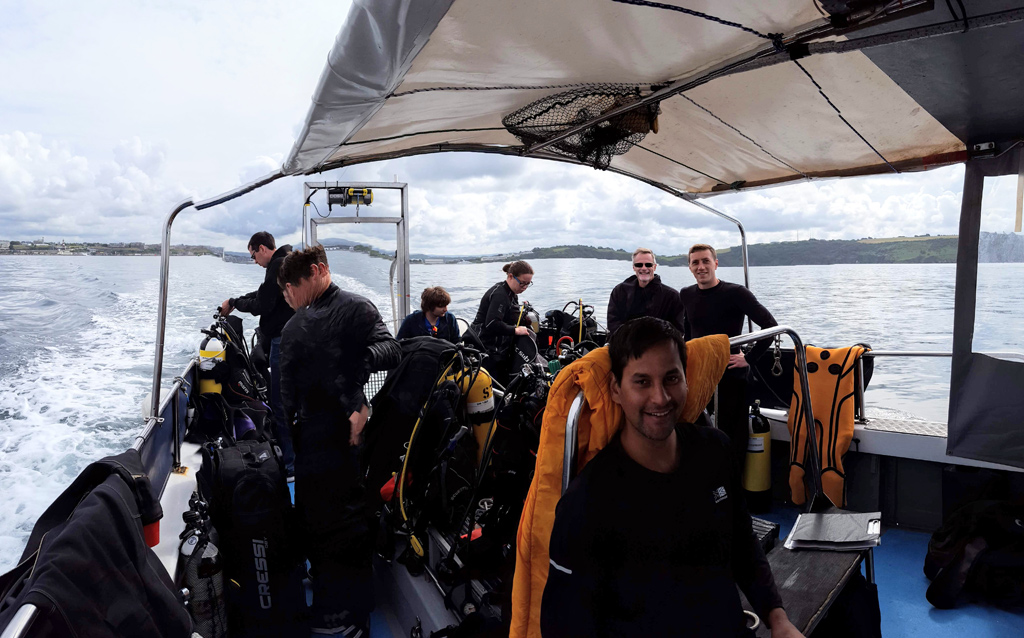
Getting ready for a dive L to R : John, Will, Paul, Emma, Rohit(foreground), Julian and Dave
Although the appeal of Plymouth is the wreck diving, the two dives we did, on Penlee Ridges and New Rock reefs proved remarkably enjoyable, thanks, no doubt, to the excellent visibilty.
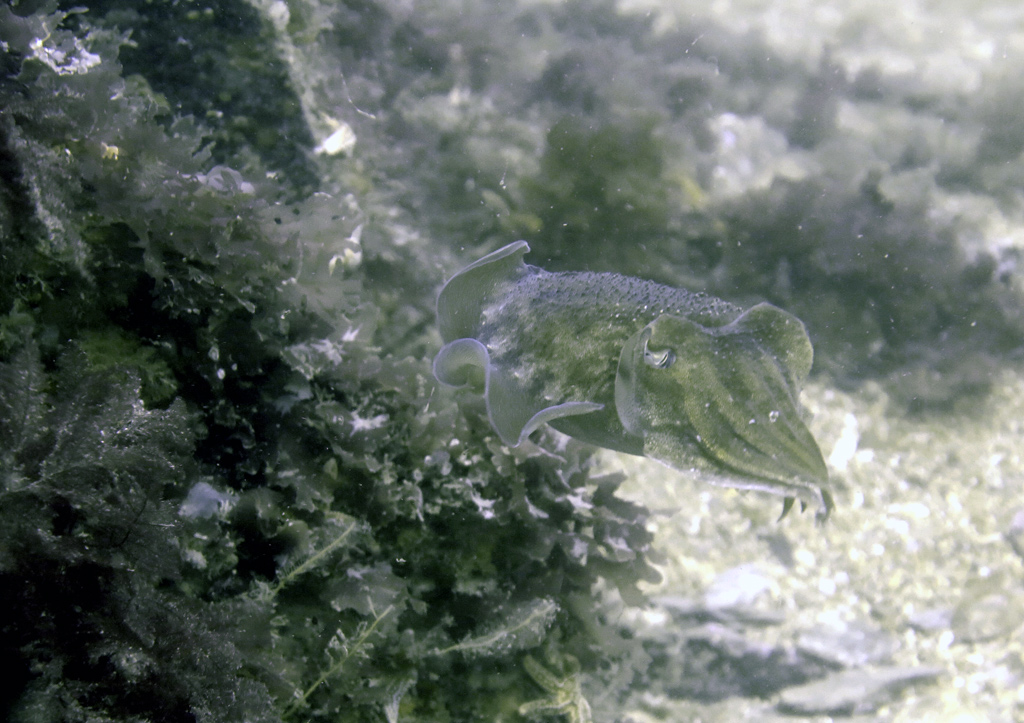
Cuttlefish on Penlee Ridges
We dived right up against the coast on Penlee Ridges first, which are a load of rock gullies, full of life on this visit (a previous one was notable in its lack of interest, I recalled), including crabs, lobsters, wrasse and dogfish.
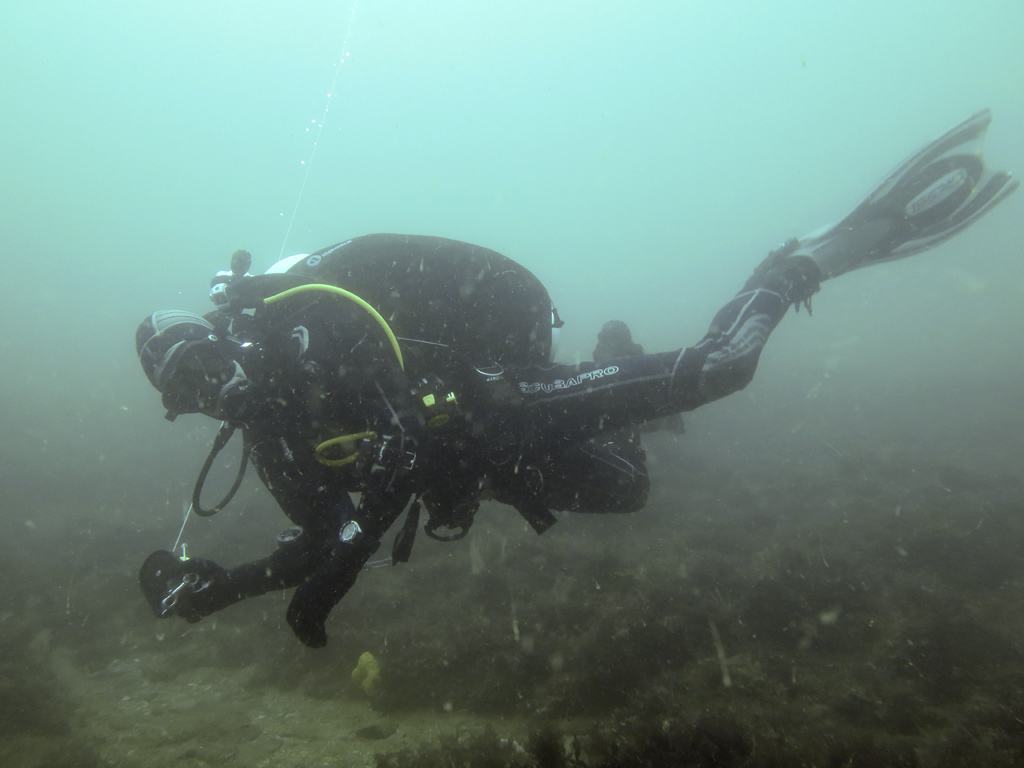
Julian on Penlee Ridges
Everyone was remarkably positive about this dive and not just because we'd been in the water.
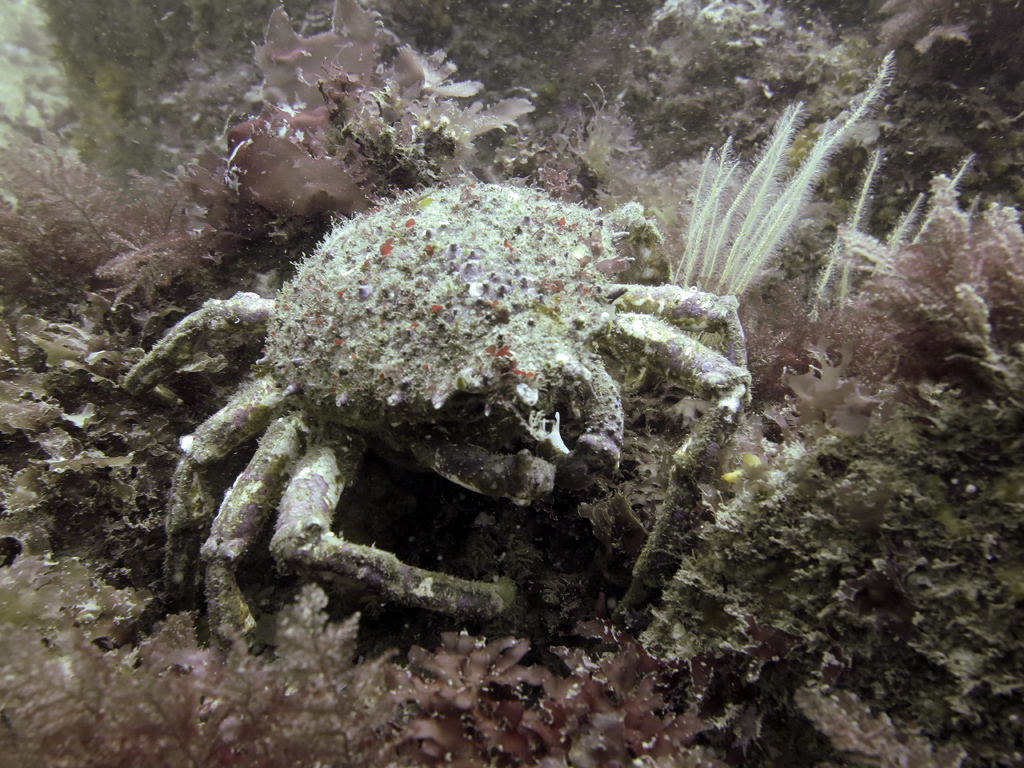
Lots of Spider Crabs around
After some tasty pasties from Pete and a suitable surface interval, we motored a short distance to dive on New Rock.
To be honest, this was pretty similar, with less gullies and more sand, but once again everyone was pretty positive about the dive, except poor old Dave Twyford, whose wrist seal had split and flood his suit on the previous dive!
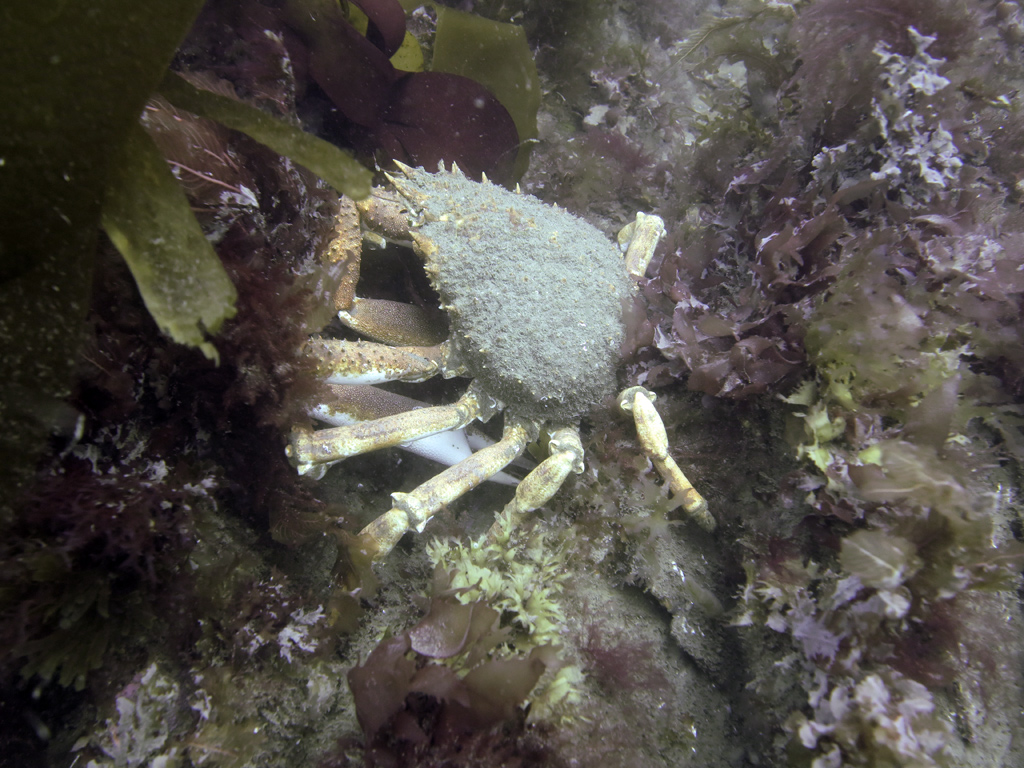
Another Spider Crab on New Rock
Luckily for him Aquanauts' boat agreed to repair his suit overnight, so he was back diving the following day!
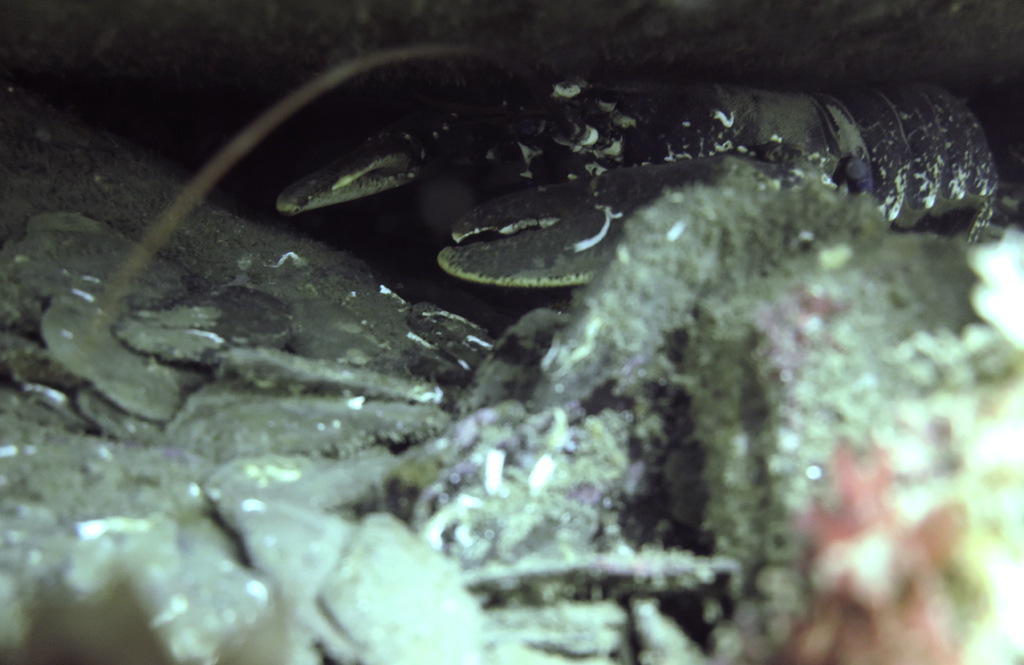
Big Lobster living under a rock cube
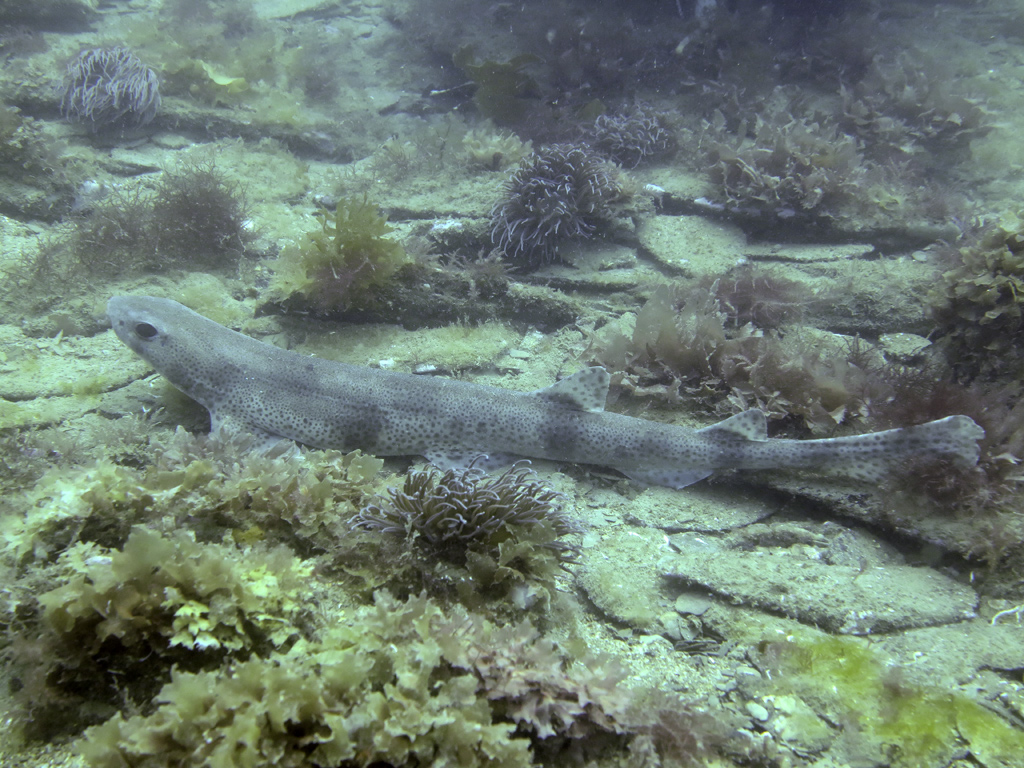
Relaxed Dogfish on New Rock
Another of our club, Paul, had less luck, though, as his car had broken down on the way to Plymouth and had been recovered home, so never made it.
With two local dives, we were back early and took our cylinders into Aquanauts to be filled, which proved expensive as many of us came out of the shop with some new dive kit!
Dinner was at the Harbour seafood restaurant on the Barbican. The food's OK, but I think it's a bit dear for what you get and we adjourned to a very rough pub, afterwards, where I enjoyed an excellent pint of a beer called Sea Fury.
After a decent night's sleep and another full English, we said goodbye to the Moorings and returned to the boat, via Aquanauts where we had to collect our cylinders of Nitrox (and produce our certification cards).
The weather was much kinder on Sunday and we set off to the Rosehill for our first dive.
Sunk towards the end of WW1 and lying upside down, the Rosehill is a bit like a number of south coast WW1 wrecks, lots of plates, a few recognisable parts (boilers, engines, bollards, anchors) and hundreds of pretty large fish.
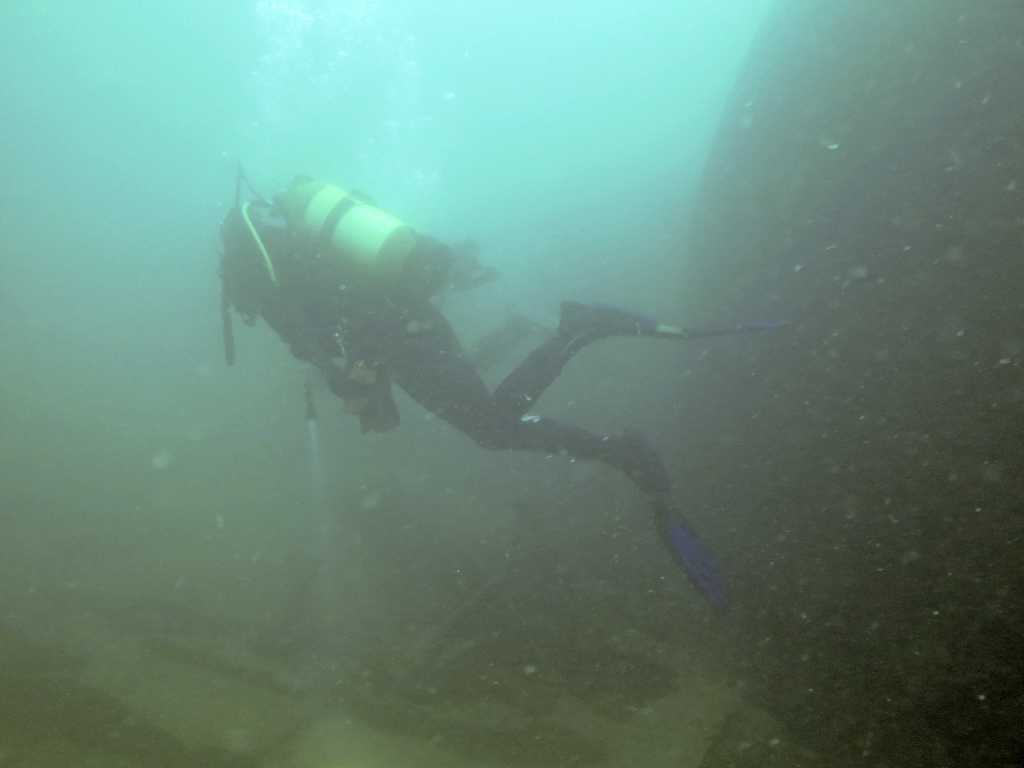
Rohit passes one of the boilers on The Rosehill
Being over 30M deep, we wondered if this would be a dark, gloomy dive, but even that far down torches weren't required and we all enjoyed a good dive, although my dive was compromised a little by diving with a diver on air, which cut our time a bit short, but that left more gas for the second dive of the day.
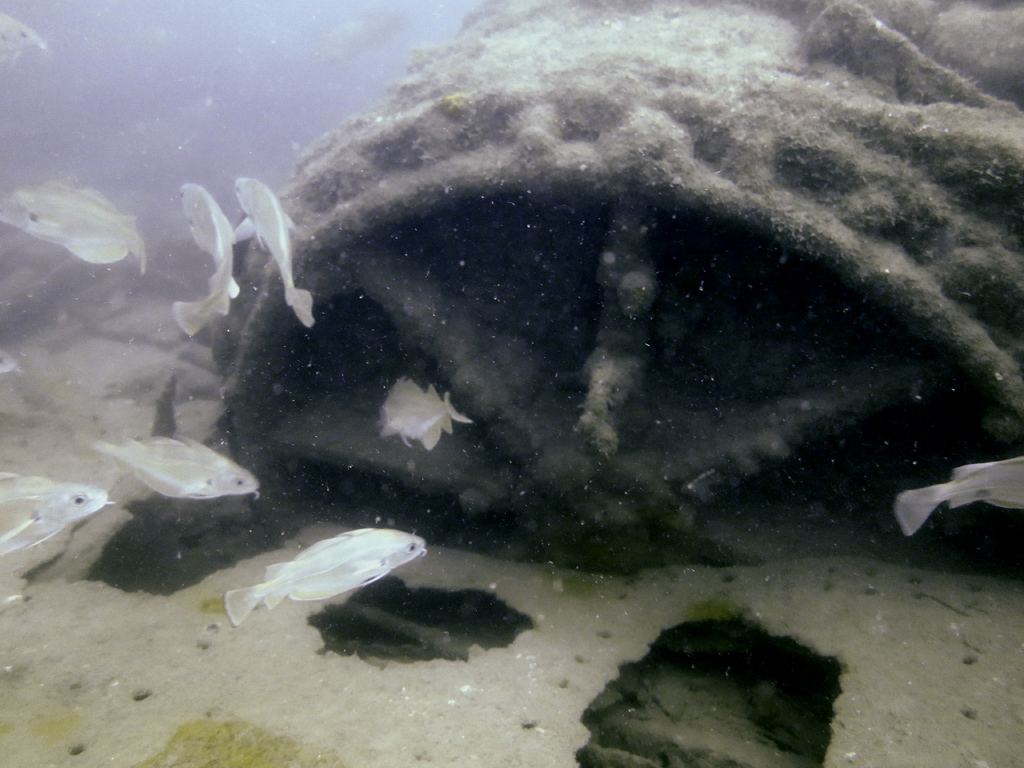
Lots of fish and good vis on The Rosehill
That second dive was to our old favourite, HMS Scylla. OK, it's a purposely sunk wreck, but it remains a great one to explore.
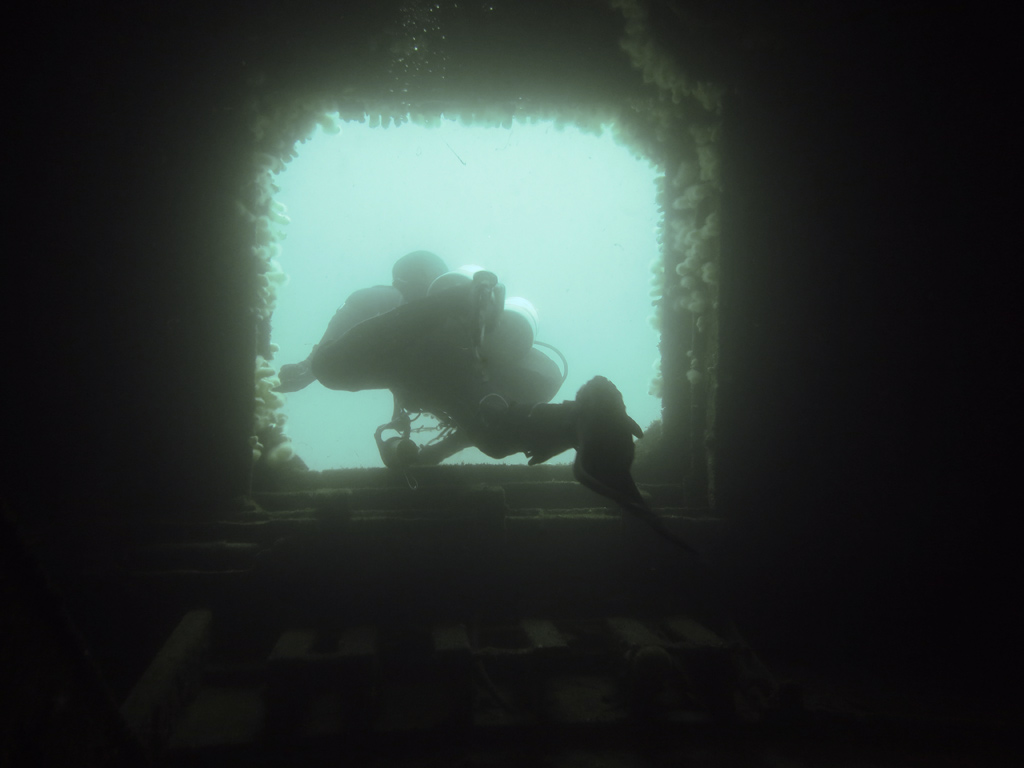
Julian and I explore HMS Scylla
It's beginning to crumble, but with fantastic light and vis, this was my best dive on it ever, with Julian and I exploring plenty of swim throughs as we explored around the ship in a near 40 minute dive.
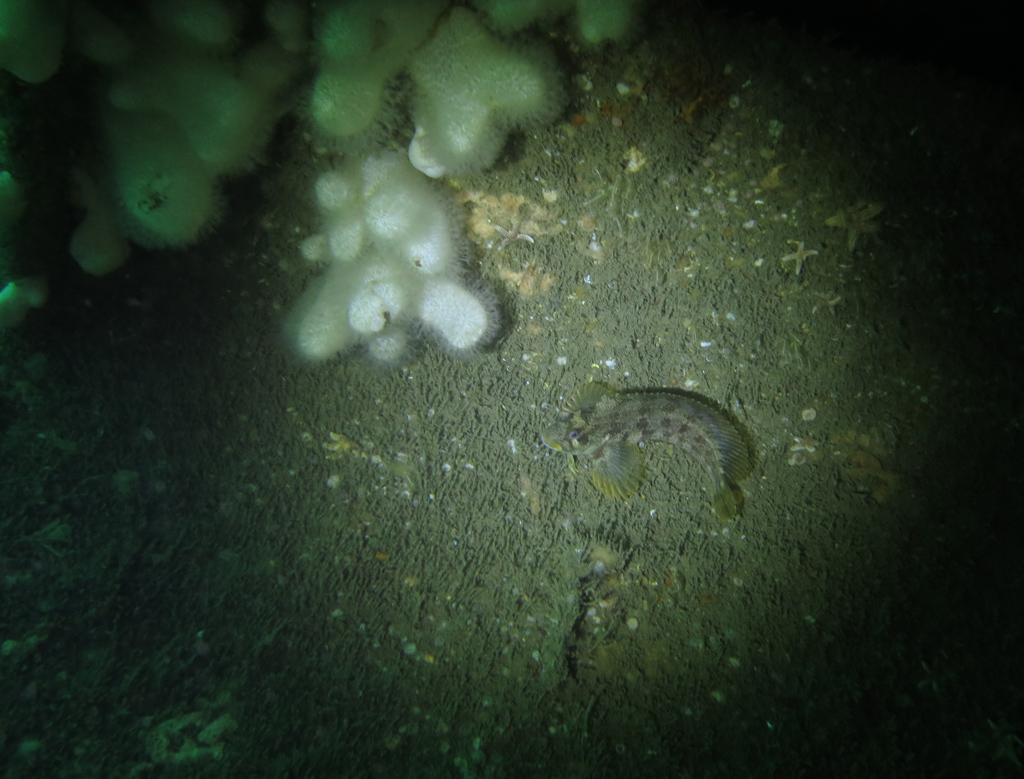
Blenny on Scylla
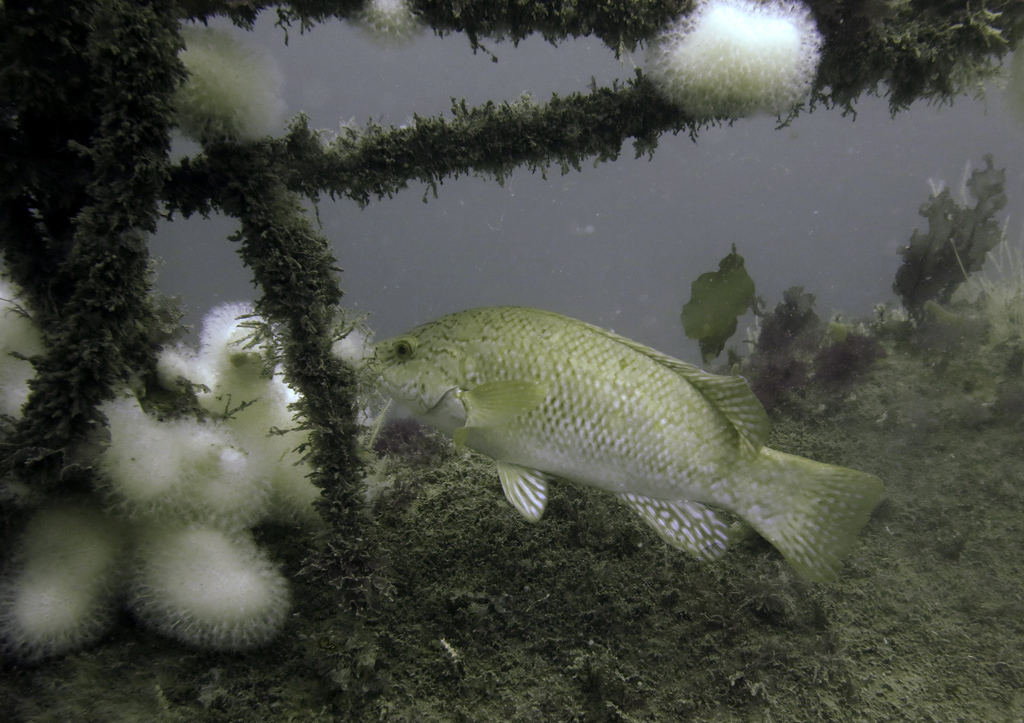
Wrasse on Scylla
I went to a few places I'd never been before, certainly, but looking into some of the openings in the hull lower down the ship, the warnings of fallen cables and collapses ceilings were clearly visible as valid.
The drive home took about 3.5 hours, which is pretty good and rounded out a great weekend's diving - Sometimes the journey can take the shine of Plymouth trips a little, but no such problem in 2019.
Shipwreck Project, Weymouth, June 2019
The weekend after Plymouth, we were supposed to head to Weymouth to repeat the 'Shipwreck Project' event that I'd taken part in in 2018, this time over 5 days.
Sadly, by the Thursday evening before it was clear that the June weather wasn't good and with strong southerly winds blowing the weekend days were cancelled with a decision to be made on the weekdays on the Saturday, as the weather forecast looked better, at least for the Tuesday and Wednesday.
So,after spending the weekend watching the Le Mans 24 Hours on TV and having an unexpected, but very enjoyable, Father's Day mail with the family, Julian and I headed off to Portland on the Sunday evening.
The forecast was still patchy for the Monday, but looked better for the Tuesday and Wednesday.
It was an early start as we set off from the Royal Breakwater Hotel in Portland, too early for breakfast, and we were putting our kit aboard the boat about 7AM.
Richard Bright-Paul, the skipper, predicted that diving on the east side of Portland Bill would probably be OK, but that it was doubtful that it would be good enough to visit our second site, on the West side, that day.
I dived with Steve Batt on the first day, dropping in and laying out a line and tape measures out for the team with the metal detector to use as references to record 'hits' with the detector.
The dive was reasonably uneventful, but it's definitely different diving with a job at hand, compared to the usual 'site seeing' type of diving I do, requiring more of you in terms of task loading and paying attention to depth, NDLs and gas.
Unfortunately, a lot of the team's good work was done when the grapnel snagged the North/South reference live when being lifted, tearing it out of the sea bed.
When we returned to the boat, we were told it was too rough to visit the second site, so we were to do a drift dive off Lulworth Banks (South of Lulworth Cove).
This was a c. 22M dive and fairly uneventful with little to see, except a few crabs, lobsters and fish and a fair number of either inert or unexploded ordnance, fired from the ranges!
I must admit to feeling pretty tired out on the first day, but after a debrief to discuss the effectiveness of our approach (everyone agreed it went fairly well) and plan for the second day and a shower we headed off to Cove House Hotel, overlooking Chesil Beach and enjoyed (in my case) a great meal of Scallops and a pint of Adnams and then a stunning sunset over a very calm looking Chesil Cove.
We were up a little later the following day, so got a cooked breakfast at 6:20AM(!) before heading back to the boat.
We'd refilled our cylinders at Old Harbour Dive centre on the harbour side in Weymouth the previous afternoon and so only had to put those back aboard, along with the newly prepared lines to replace the one lost on the seabed the previous day.
Our first dive was back on the wreck to the East of Portland Bill again, but it turned out that the shot wasn't on the expected part of the wreck, possibly lifted as the divers descended, so the first team only had time to lay the southerly line after relocating our agreed 'Point 0' or centre point for marking out.
As the third team in, Julian and I expected to find a line to follow tos scan using the (still only one) metal detector, but in fact there was no north line to follow, so we laid that and then quickly scanned along the two tapes that were laid, before returning to the surface.
As we ate lunch, we motored around Chesil Beach and planned the second dive.
The approach was much the same as the previous day and Julian and I went back in as team 3 again, with the metal detector. There was no problem with lines and the visibility was OK (maybe 5M or so), but we didn't find many hits at all.
We refilled our cylinders in Underwater Explorers in Portland and headed back to the hotel again.
In the debrief, we decided to scan a different area on the Chesil dive site, to see if we turned up more 'hits' the following day, especially as another two metal detectors had finally arrived for us to use.
We at a very decent Curry in Shalim's Balti House in Weymouth (we've eaten there a few times now and it's always good) and a quick beer after that in the Green Shutters on Portland, which seemed a pretty nice pub for Portland!
Armed with 3 metal detectors, although one turned out to be giving unreliable readings on the first dive, we planned to do less laying out and more detecting.
On the first wreck, east of Portland Bill again, Julian and I did some detecting on a couple of 4m wide East/West corridors. To be honest, neither was especially forthcoming in finds, but that was the point of the project, to increase our understanding of the extent of the wreck.
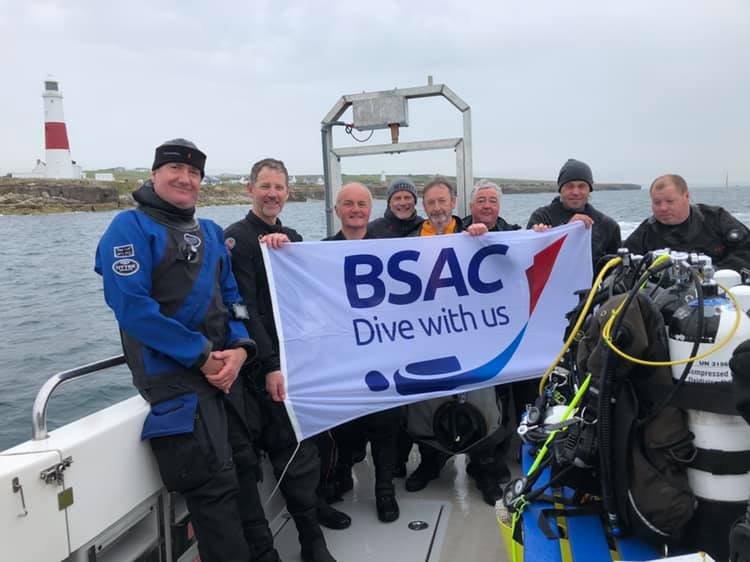
The team pose for a photo for BSAC - Cameron's photo
On the second wreck, off Chesil Beach, we were both lowish on air and offered our detector to a team who had had the faulty detector on the first dive as we thought it fair to give them a go and that we may not have time to complete 3 scans as planned.
The plan on this dive was for us to act as 'cleanup crew', picking up any tape measures or lines left by the scanners.
For a variety of reasons (forgotten weight belts for one of the teams - Buddy checks anyone? - and the turning of the tide amongst them), we spent about 15 minutes mooching around on the seabed, before starting to bring in kit.
To my surprise, one team had left their entire kit, including a bag, three tape measures, some stakes and even a hammer! Soon our bag was getting pretty heavy to move around.
However, by the time we'd reeled in the distance line laid from our original point zero (and the shot) to the new point zero for this dive, we still had a decent amount of gas, but then we spotted another north-south line that we'd not expected!
We should have left it as it turned out (the brief was, though, to 'bring up everything', but we didn't and, although we made it back to the boat with air, we had a little less than we'd have preferred. Still, a rule of diving was reinforced, safety comes before tasks! 'Diving with a purpose' does increase the risk of doing 'just one more thing' and reducing your safety margin.
All said and done, though, and allowing for the loss of the weekend days, the project had been pretty successful. We'd scanned and mapped a fair area around both wrecks that we'd not done so in the previous year and had a fair number of enjoyable, if more task orientated than we're used to, dives.
I didn't take any photos underwater on this trip as the light and vis were not a patch on the stunning conditions of 2018
Holland V Submarine and Norman's Bay Cannon Train, June 2019
On the 24th June, Julian and I set off early to dive the protected wreck site of the Holland V (Five) submarine, with the NAS.
With ropes off at 8:30 and Google suggesting a journey time to Eastbourne of up to 2h 45 minutes, it was a 5AM start for me, but being mid June it was, at least, daylight and the weather, while not sunny was dry for our leisurely drive down, which we completed in 1h 45m!
After a quick coffee and bacon roll in McDonalds (not my favourite place, but there weren't many options at 7:30!) we parked up at Soverign Harbour and unpacked our twinsets and the rest of our kit.
Dive 125 arrived promptly and we quickly loaded up and motored out of the locks to head out towards the Holland V, passing seals on the beach as we went!
The sea was slightly choppy on the way out and the sun refused to shine through the high clouds, but neither was a big problem and after passing the Soverign Tower light house we arrived in the middle of nowhere, just in sight of land, after about an hour's steady motoring.
The Holland V is a protected wreck, so opportunities to dive it are very limited with only a handful of trips out to it each year. Paul, another member of our club, who dived it in 2018, had had 4 attempts scuppered by the weather before doing so, so we were pleased to have got there on our first attempt.
Mark from NAS gave his usual detailed and informative briefing on the submarine (actually the first to go into service with the Royal Navy - I thought that honour went to the bigger A1, but I was clearly wrong!), both its layout and history and what we would find now, including showing us a scale model, generated from photogramatary,of the sub on the sea bed, detailed down to the sandbank that has built up on one side!
Mark and Sarah from NAS went in first, to check the shot was on the wreck, but very quickly put up a signal for us to follow, so the skipper had done his job well.
After a bit of trouble finding my inflator hose, meaning I bobbed on the surface for a couple of minutes, we descended down the shot to around 25M.
At this point, even on a quite overcast day, we could make out the unmistakable sight of the submarine we'd seen in the model, sitting (as subs seem to do) upright on the seabed, as if waiting for orders to rise up and sail away).
We landed just off the stern, where the propellor was visible and it's boss lies on the sea bed off to the starboard side.
There's a scour under the hull here (the lower element of the rudder is still in place, but parts of the upper and hydroplanes lie on the seabed) where a large number of Bib congregated.
Moving along the starboard side, we swam up onto the upper hull, over the engine exhaust ports, ball joint for the periscope (missing) and the tiny one-man conning tower.
We dropped over to the port side ahead of this, noticing lots of crabs and blennies living in knooks and crannies on the upper deck and then swam around to the bow where the single torpedo tube is open.
Video of the Holland V dive
One theory as to the loss (with no crew as it was undertow to dismantling, luckily) is that the torpedo tube flooded and the inner door wasn't secured, flooding the whole sub, until it was too heavy to tow and was cut loose to sink where it now lies.
We swam back along the starboard bow and then just around and around as the sub is so small, you could swim around it in 10 or less minutes!
That said, it's life and completeness make it a great dive, helped on our visit by near 10M vis and decent light, meaning torches were only really needed to illuminate some of the life or look cool on video!
We spotted a couple of Congers on the wreck. One small one in a tube on the upper deck and another, barely, visible through a hole in the hull towards the rear, where Mark from NAS' excellent briefing told us the engine room was.
We headed for the surface just as Julian was reaching his NDL and carried out a peaceful safety stop, only slightly enlivened by the presence of a rather menancing looking jellyfish!
Addendum:In December 2019, I visited the Royal Navy Submarine Museum, in Gosport, where the Holland 1 is on display, well worth a visit.
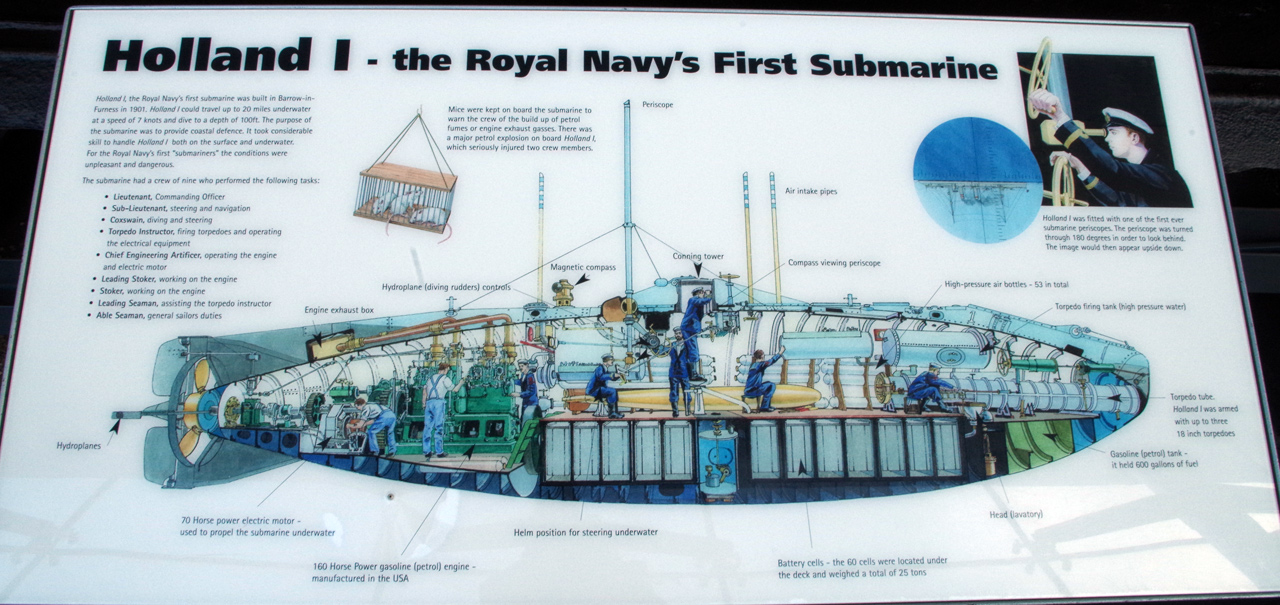
A diagram of the Holland class subs, from the RN Submarine Museum
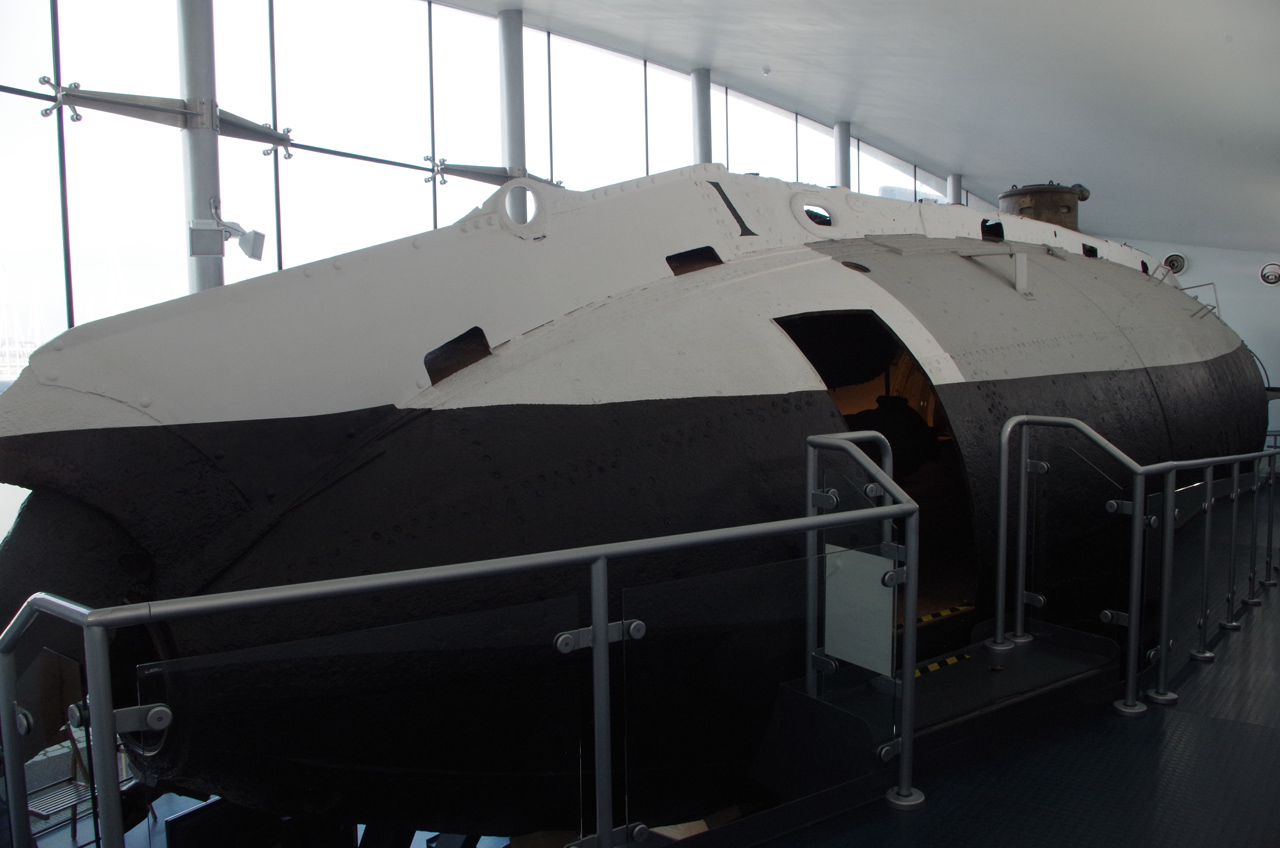
The Holland 1 at the RN Submarine Museum in December 2019
Mark from NAS videoed me for my review of the dive afterwards :
Buzzing with that, we headed fairly leisurely back towards land and the Normans Bay Cannon Trail.
This site is the remains of a Dutch Man of War that sank during the Battle of Beachy Head in 1690 (yeah, me neither...).
It's very shallow (max depth was 12.5M) and vis is quite limited, but it does have a huge anchor and, most importantly, over 50 Iron Cannons lying scattered around the site.
Julian and I got separated on the descent. This was my fault, as I missed the shot, trying to stow my DSMB and couldn't swim back to it due to a slight current.
I thought maybe I could swim against it a few feet down, but failed and found myself on the bottom without him, but sitting next to the Anchor, right in the middle of the wreck.
Off to one side I spotted a pair of blue fins, but these turned out to be Sarah, from NAS', who was carrying out some remedial work on some of the lines and markers that help you navigate the site in poor vis.
I found the 'way out' marker on the line, so figured Julian may still be at the start point. Sure enough, I got back to it, just as he was about to head back to the surface, so we carried on together, travelling along the lines (and venturing off them a little now and then to explore a particular cannon) between the dozens of Cannons.
Short video from the Normans Bay dive
At one extreme of the site, a pair of cannons point upward at 45 degrees like a WW2 battleships and at another point a pair are almost vertical forming an arch you can (just about) swim through!
As a second dive and a counterpoint to the Holland V, this was a hugely enjoyable dive and we spent 45 minutes mooching around with no worries about gas or NDLs.
The vis wasn't great, but Mark (from NAS) said it was pretty good for that site and, as Julian said, nothing to worry divers who frequently dive in Wraysbury!
Read some more of my diving experiences, by clicking the icons below.


